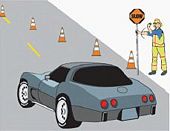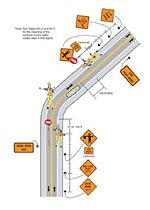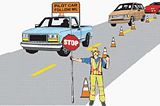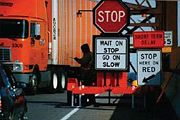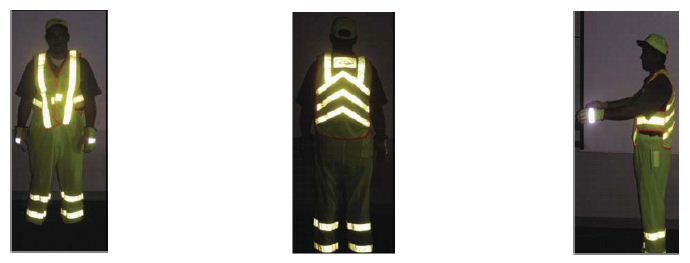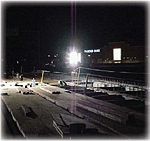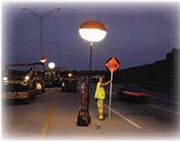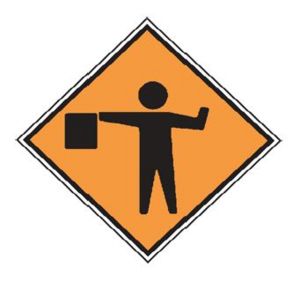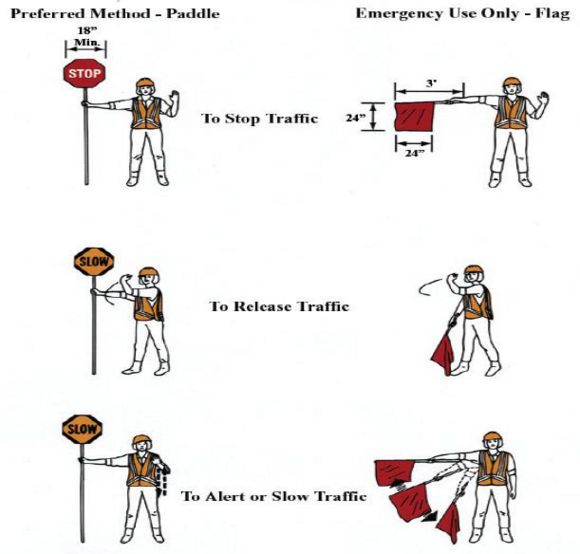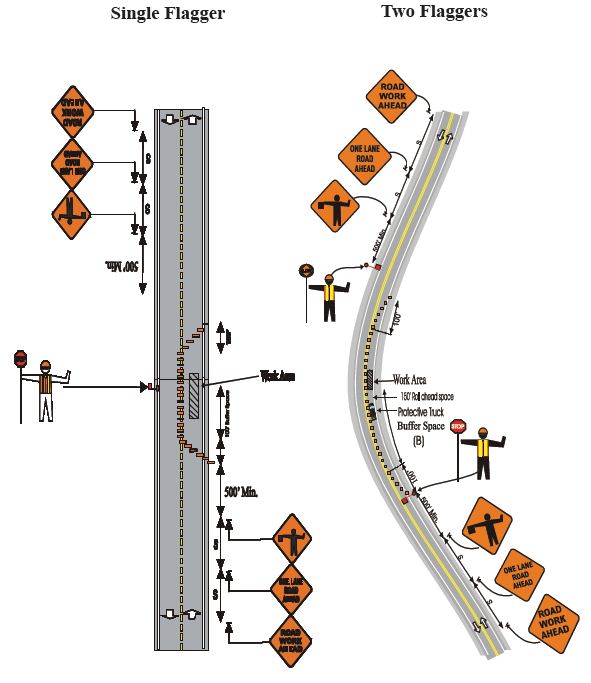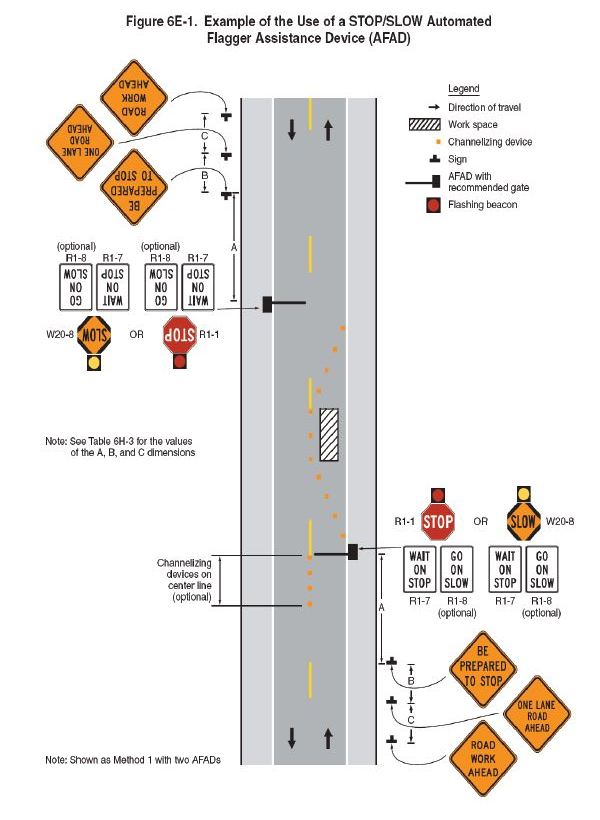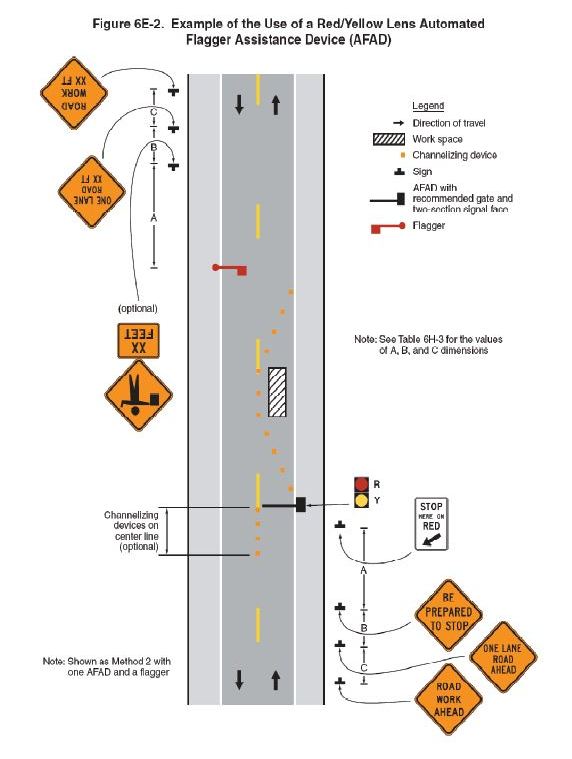Difference between revisions of "616.20 Flagger Training"
m (Per Traffic, flagger training pdf updated) |
m (→Clothing: Updated link, per Traffic) |
||
| Line 89: | Line 89: | ||
:* Clothing shall be in accordance with [http://lnapp1/RI/RIManual.NSF/SHToC?OpenView MoDOT’s Safety Rules and Regulations]. | :* Clothing shall be in accordance with [http://lnapp1/RI/RIManual.NSF/SHToC?OpenView MoDOT’s Safety Rules and Regulations]. | ||
| − | + | {|style="padding: 0.3em; margin-left:15px; border:2px solid #a9a9a9; text-align:center; font-size: 95%; background:#f5f5f5" width="270px" align="right" | |
| − | :* All [http://lnapp1/RI/RIManual.NSF/ | + | |- |
| + | |'''*''' To reference the PPE guidelines, scroll down to 1.6 Class II and III Safety Apparel. | ||
| + | |} | ||
| + | :* All [http://lnapp1/RI/RIManual.NSF/SHToC?OpenView PPE* (Personal Protective Equipment)] worn during nighttime operations shall be retroreflective. | ||
:* Vest, shirt, jacket or pants (when required) shall be MoDOT approved. | :* Vest, shirt, jacket or pants (when required) shall be MoDOT approved. | ||
Revision as of 12:58, 24 May 2012
| Handbook | |
| Flagger Training Booklet, 2010 | |
| Video | |
This article has been developed following the guidance and procedures of the Manual on Uniform Traffic Control Devices, 2009 edition (MUTCD) and the specifications of the Missouri Department of Transportation. These instructions have been prepared for employees of MoDOT, contractors, and other entities that are assigned flagging duties in work zones on public streets and highways.
Contents
Introduction
Remember, as a flagger, your duties are to protect MoDOT personnel and provide safe, courteous and authoritative directions to traffic seeking passage through the work area. Your job is the most important one on the crew. The lives of all individuals in the work zone depend on YOU.
The following information is designed to give you some basic guidelines regarding flagging operations. Familiarize yourself with these procedures. If you have any questions or concerns, do not hesitate to ask your supervisor.
For your personal safety as a flagger, always face toward traffic and stand outside the path of an approaching vehicle.
Flagging should only be used when all other traffic control devices are inadequate to warn and direct traffic. Prior to operating any equipment, employees shall complete the appropriate required training.
Guidance for Flagger Duration
Flaggers should not flag for more than two hours at one time, unless it is an emergency situation. Supervisors shall provide flaggers with a 15-minute break from flagging in non-emergency situations. The supervisor should consider environmental, physical and work factors when determining appropriate flagging and break durations in the field.
Course Contents
At the end of this class, you should be able to:
- List the qualifications of a flagger
- Understand section 6E of the Manual on Uniform Traffic Control Devices (MUTCD)
- Describe why flagging is important
- Determine the necessary equipment needed to flag
- Utilize proper hand signals while flagging
- Set up and handle one-lane traffic on a two-way road
- Use various methods to communicate with other flaggers
- Recognize different types of drivers and how to deal with them
- Handle nighttime flagging operations
- Communicate with the traveling public, crew workers and supervisors
Work Zone Manuals
MoDOT’s governing manuals for flagger and work zone operations are:
- Manual on Uniform Traffic Control Devices (MUTCD)Section 6E
- Engineering Policy Guide (EPG) 616.20
Qualifications of a Flagger
A flagger is a person who provides temporary traffic control.
Because flaggers are responsible for public safety and make the greatest number of contacts with the public of all highway workers, they should be trained in safe traffic control practices and public contact techniques.
Flaggers should be able to satisfactorily demonstrate the following abilities:
- 1. Ability to receive and communicate specific instructions clearly, firmly, and courteously;
- 2. Ability to move and maneuver quickly in order to avoid danger from errant vehicles;
- 3. Ability to control signaling devices (such as paddles and flags) in order to provide clear and positive guidance to drivers approaching a Temporary Traffic Control (TTC) zone in frequently changing situations;
- 4. Ability to understand and apply safe traffic control practices, sometimes in stressful or emergency situations; and
- 5. Ability to recognize dangerous traffic situations and warn workers in sufficient time to avoid injury.
Clothing
As a flagger, you are required to be clean, neat, and fully dressed at all times when on the job, either day or night. Be prepared for changing weather conditions by bringing suitable clothing and other necessary things such as sun screen, insect repellant and water. You are the first person the traveling public will encounter; sloppy dress or appearance will not be tolerated and will present a nonprofessional image. Remember, a neat appearance commands respect.
Employees shall wear personal protective equipment (PPE) appropriate for each hazard. The department will provide required protective equipment for use by the employees. Supervisors shall control the issuance and replacement of this equipment. When PPE is furnished to the employee, it is the responsibility of the employee to use and maintain it as specified by MoDOT and the manufacturer.
For daytime and nighttime activity, flaggers shall wear MoDOT approved safety apparel that meets the Performance Class 2 or 3 requirements of the ANSI/ISEA 107–2004 publication entitled “American National Standard for High-Visibility Apparel and Headwear”. Requirements are as follows:
- Type 2 apparel, MoDOT approved vest and hat for daytime operations.
- Type 3 apparel and a hat shall be worn during nighttime flagging operations.
- Clothing shall be in accordance with MoDOT’s Safety Rules and Regulations.
| * To reference the PPE guidelines, scroll down to 1.6 Class II and III Safety Apparel. |
- All PPE* (Personal Protective Equipment) worn during nighttime operations shall be retroreflective.
- Vest, shirt, jacket or pants (when required) shall be MoDOT approved.
Retroreflective clothing shall:
- Be visible at a minimum distance of 1000 ft. for nighttime flagging.
- Identify the wearer as a person.
Remember
As a flagger, your number one consideration is SAFETY - the safety of:
- Yourself
- The workers
- The traveling public
To the traveling public, you are the most important person in the construction zone.
Flagger Stations
Prior to the start of flagging operations, all signs should be in place. A good flagger location is one where the sight distance is sufficient and the flagger is clearly visible to approaching motorists, workers and, when practical, the other flagger(s).
In stationary operations, the flagger should be positioned a distance equal to the appropriate sign spacing, typically 500 ft. from the flagger symbol sign. For mobile operations, spacing between flagger and flagger symbol sign shall not exceed one mile. When the maximum allowable work zone length cannot be attained due to this limitation, additional flagger symbol signs may be staged throughout the length of the work zone. In such instances, the flagger symbol signs are set up and knocked down as work progresses so only one sign is displayed in each direction and that sign is no more than one mile in advance of the flagger.
When more than one flagger is being used, all communication procedures should be clear before any flagging begins. If there is a major intersection within the closed area, an additional flagger may be needed to control traffic entering the temporary traffic control zone from the major intersection.
Law enforcement personnel should be secured to perform flagging functions, when needed, at intersections fully-controlled by an active traffic signal or stop signs. Law enforcement personnel are the only ones who can legally assign right of way through an intersection when the assignment is opposed to inplace traffic control.
When flagging on a rural undivided highway, the length of the work zone should not exceed three miles. When flagging in an Urban area, the length of a work zone should not exceed one mile. When work is completed and flaggers are off the road, remove work zone signs promptly.
Emergency vehicles have right of way priority in a work zone; only allow them to proceed when safe to do so and communications. between all flaggers have occurred.
Flagging Equipment
Stop/Slow Paddle
- Shall be retroreflective
- Shall be octagonal shape on a rigid handle at least 7’ in length
- Shall be 18” wide with letters at least 6” high
- The stop face shall have a white border with a red background
- The slow face shall have black letters on a black border on an orange background
- The stop/slow paddle shall be retroreflective at night
Flags
- In emergency situations, a minimum size 24” x 24” red flag on a 3’ staff may be used in place of a paddle until a paddle is available. However, as soon as a paddle is available it shall be used.
- When flags are used at night, they shall be retroreflective.
Communication Devices
- When required, flaggers shall be equipped with a portable, two-way, FCC approved communication system. The two flaggers must be able to see each other or be equipped with an appropriate communication device.
Flagger Situations
You, the flagger, should stand either on the shoulder adjacent to the traffic being controlled or, in limited circumstances, in the barricaded lane. In rural areas, your position will normally be on the right shoulder of the roadway and in urban areas, on the right curb. Your location may differ according to conditions, especially on multilane highways and streets. In some locations, to operate effectively, a position may have to be taken on the shoulder opposite the barricaded section. You should only stand in the lane being used by traffic after traffic has stopped. Stand where oncoming traffic can see you. Make sure you are visible, not standing where the sun or a shadow makes it hard to see you.
Flagger Station
- Located in advanced warning area.
- Be alert, remain standing at all times.
- Always face oncoming traffic and stand outside the path of an approaching vehicle.
- A flagger’s normal station is on the shoulder of the road, minimum of 500 ft. from the flagger symbol sign and minimum of 100 ft. from the workspace.
- Park your vehicle off the road, away from your station.
- Stand alone, do not mingle with the work crew or the public.
- Make sure you are visible to oncoming traffic, not standing where the sun is impeding visibility or in a shadow.
- Stand in a location that allows approaching traffic adequate time to respond.
- Have a planned escape route.
Factors That Affect Sight Distances
You should be visible for at least 500 ft. in daytime operations, 1000 ft. for nighttime operations, or more if conditions warrant. What are some of the things that might hide you from the driver’s sight?
- Hills
- Curves
- Obstructions
- Shade – hard to see people in shaded area
- Color contrast – wearing an orange vest and standing next to a similarly colored truck
- Bad weather
- Darkness
| Note: If it’s a minimum value, you can go greater. If it’s a maximum value, you can go less. Use no less than the minimum value and no more than the maximum value. |
Single Flagger
There are two different applications of the single flagger situation.
1. A single flagger may be used when all three of the following are met:
- Traffic volumes are less than 500 vehicles per day
- Sight distance in both directions is greater than 1000 ft.
- The activity area is less than 500 ft.
- Note: The flagger should have:
- A safe location to stand
- A planned escape route
2. A single flagger may also be used for short-term, single lane closures. An example would be a truck depositing material off the edge of the roadway. In this situation, the flagger would stop the traffic in this lane while the other lane flows free. When the lane is opened again, the flagger allows the traffic to proceed in their normal lane. After stopped traffic is allowed to proceed, the flagger should turn the STOP/SLOW paddle parallel to the flagger so that no message is displayed to either direction of traffic.
| Note: Single flagging procedures should not be conducted during nighttime work zone operations. |
Two Flaggers When two flaggers are required, lines of communication must be established prior to the start of flagging operations. The two flaggers must be able to see each other or have a communication device designated for proper communication. One flagger should be the lead flagger and coordinate all activities.
Always use appropriate advance warning signs, giving particular attention to sign visibility, legibility and placement.
Remember to always remove signs or completely cover the sign messages when they do not apply to present traffic control conditions.
Advance Flagger
An advance flagger may be used where there is limited sight distance to the activity area or where long lines of traffic form. The decision to use an advance flagger should be made at the Supervisor level at the work zone. As an advance flagger, you should stop each vehicle as it approaches, inform the driver of the situation ahead, and explain the actions required such as: “fresh oil ahead, drive slowly,” “keep to the right and stay in line,” etc. Where there are long lines of stopped traffic waiting to proceed, the advance flagger should move down the line and inform each driver of the reason for the delay and the approximate length of the delay. Be considerate, alert, and avoid unnecessary conversation.
Pilot Vehicle
The use of a pilot vehicle is a safe and efficient means of moving traffic when a lane must be shared by traffic going both directions and the work zone area is lengthy or difficult to navigate. Two flaggers must be used when using a pilot vehicle. You will stop traffic following the usual procedures and hold the vehicles until the pilot vehicle arrives. The pilot vehicle will move to the head of the line of waiting vehicles and you will release the vehicles to follow the pilot vehicle back to the other flagger. After the line of cars has passed your station and there is a gap in traffic, you will again stop the oncoming traffic and hold the vehicles until the pilot vehicle returns.
When a pilot vehicle is used, traffic delays should be limited to 15 minutes. If the wait is longer, inform your supervisor and an additional pilot vehicle may be used to keep the delay time within the 15-minute limit.
Automated Flagger Assistance Devices
Automated Flagger Assistance Devices (AFADs) enable a flagger(s) to be positioned out of the lane of traffic and are used to control road users through temporary traffic control zones. These devices are designed to be remotely operated either by a single flagger at one end of the TTC zone or at a central location, or by separate flaggers near each device’s location.
There are two types of AFADs:
- 1. An AFAD (see Section 6E.05 of the MUTCD) that uses a remotely controlled STOP/SLOW sign on either a trailer or a movable cart system to alternately control right-of-way.
- 2. An AFAD (see Section 6E.06 of the MUTCD) that uses remotely controlled red and yellow lenses and a gate arm to alternately control right-of-way.
AFADs might be appropriate for short-term and intermediate term activities. Typical applications include Temporary Traffic Control (TTC) activities such as, but not limited to:
- 1. Bridge maintenance
- 2. Haul road crossings
- 3. Pavement patching
| Note: When an AFAD is used, the advance warning signing should include a ROAD WORK AHEAD sign, a ONE LANE ROAD sign, and a BE PREPARED TO STOP sign. |
| Note: When the AFAD is not in use, the signs associated with the AFAD, both at the AFAD location and in advance, shall be removed or covered. |
STOP/SLOW Automated Flagger Assistance Devices
A STOP/SLOW Automated Flagger Assistance Device (AFAD) shall include a STOP/SLOW sign that alternately displays the STOP face and the SLOW face of a STOP/SLOW paddle.
Red/Yellow Lens Automated Flagger Assistance Devices
A Red/Yellow Lens Automated Flagger Assistance Device shall alternately display a steadily illuminated CIRCULAR RED lens and a flashing CIRCULAR YELLOW lens to control traffic without the need for a flagger in the immediate vicinity of the AFAD or on the roadway.
A Stop Here On Red sign shall be installed on the right-hand side of the approach at the point at which drivers are expected to stop when the steady CIRCULAR RED lens is illuminated. See AFAD diagram.
Requirements for Nighttime Flagging
Nighttime Work Zones
What is considered nighttime work? Nighttime work is work that begins one-half hour before sunset and ends one-half hour after sunrise.
Nighttime Apparel Requirements
All employees, salaried and wage, working on or near the right of way during nighttime hours, and/or where there is a routine exposure to traffic and/or equipment shall properly wear MoDOT approved Class III Safety Apparel (Class II or Class III top and Class E pants), which meets or exceeds the ANSI/ISEA 107-2004, American National Standard for High Visibility Safety Apparel.
Nighttime Flagging
When nighttime work is being performed, lighting should be used to illuminate the work area, equipment crossings and other areas. The amount and location of light provided is based on the type and detail of work being performed and the degree of difficulty in navigating the work zone. Minimum required intensity for flagging operation activity is 0.6 foot-candles. (One foot-candle equals the amount of light delivered by a 1-candela light source to a 1 sq. ft. surface 1 ft. away). Work area lighting provides a minimum maintained intensity of 5 footcandles (54 lux).
Glare
Lighting shall not produce a disabling glare to approaching motorist, flaggers, or workers. Factors impacting glare are:
- Distance between driver and luminaries
- Height of luminaries
- Direction the luminaries are aimed
To minimize glare:
- Locate luminaries so that axis of candlepower is located away from the line of sight of motorists
- Luminaries should be aimed so the center of the beam axis is no greater than 60 degrees above vertical plane.
- Tower-mounted luminaries should be aimed either perpendicular or parallel to the roadway.
Area lighting illuminates specific areas significant to traffic guidance within the temporary traffic control zone during nighttime hours. Lighting of this nature is required at flagger stations and may be considered at gore areas, transitions, ingress and egress areas, equipment crossings, interarticles, and temporary signals. A minimum intensity of 0.6 footcandles in the specific area is recommended for this type of lighting. Typically, this lighting is provided by a single light on a portable lighting unit or mounted on a temporary pole. As with work lighting, lighting shall be positioned such that it does not cause glare for motorists, spill onto adjacent properties, create shadows or become a safety concern. Flagger stations in operation at night are required to be lit.
Workers Safety Considerations
Protect yourself and co-workers! Once you have been selected or assigned your flagger position by your supervisor, look over the area for one or more methods or routes of escape - a place to get to in order to avoid being injured by oncoming vehicles, regardless of the reason.
Should you observe a vehicle coming your direction, protect yourself first - THEN warn the crew.
It is a good idea to have an air horn or some type of warning device that can be heard by the crew above construction noise.
Make sure that the crew is aware of your signals and knows what to do when you sound the warning.
Remember, your job is handling traffic. Do not otherwise assist the work crew, watch construction operations instead of traffic, or engage in any other activity in addition to your duties as a flagger.
If you need a break, tell your supervisor so that another qualified flagger may relieve you.
Traffic Control Techniques
Flagging Procedures
1) To stop traffic
- Stand on shoulder
- Face traffic
- Hold STOP sign vertically to side at arm’s length
- Hold other arm outstretched with palm facing motorist
- Make eye contact with driver
- Walk towards the centerline when one or two cars have stopped
2) To release traffic
- Walk back over to shoulder
- Stand facing towards the flow of traffic
- Hold SLOW sign facing traffic at arm’s length
- Motion traffic through with sweeping motion of free arm
3) To alert or slow traffic
- Stand on shoulder
- Face traffic
- Hold SLOW sign vertically to side at arm’s length
- Lower and raise free hand slowly with palm down
4) To temporarily stop traffic
- Only one lane closed for loading/unloading
- Only one flagger
- Stop traffic as #1 above
- Wait until obstruction has passed
- Walk back to shoulder
- Stand facing towards the flow of traffic
- Turn sign parallel to shoulder, with STOP side facing flagger
- Motion traffic through with sweeping motion of free arm

